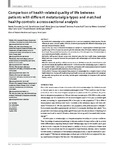Mostrar o rexistro simple do ítem
Comparison of Health-Related Quality of Life Between Patients With Different Metatarsalgia Types and Matched Healthy Controls: A Cross-Sectional Analysis
| dc.contributor.author | López-López, Daniel | |
| dc.contributor.author | Losa Iglesias, Marta Elena | |
| dc.contributor.author | Calvo-Lobo, César | |
| dc.contributor.author | Becerro-de-Bengoa-Vallejo, Ricardo | |
| dc.contributor.author | Tovaruela Carrión, Natalia | |
| dc.contributor.author | Álvarez Ruiz, Verónica | |
| dc.contributor.author | Melero González, Gemma | |
| dc.date.accessioned | 2022-02-10T11:01:37Z | |
| dc.date.available | 2022-02-10T11:01:37Z | |
| dc.date.issued | 2018-09 | |
| dc.identifier.citation | Tovaruela-Carrión, Natalia et al. Comparison of health-related quality of life between patients with different metatarsalgia types and matched healthy controls: a cross-sectional analysis. Sao Paulo Medical Journal [online]. 2018, v. 136, n. 05 [Accessed 10 February 2022] , pp. 464-471. Available from: <https://doi.org/10.1590/1516-3180.0220190918>. ISSN 1806-9460. https://doi.org/10.1590/1516-3180.0220190918. | es_ES |
| dc.identifier.uri | http://hdl.handle.net/2183/29757 | |
| dc.description.abstract | [Abstract] BACKGROUND: Metatarsalgia can be considered to be a common complaint in clinical practice. The aim of this study was to compare quality of life (QoL) between participants with different metatarsalgia types and matched-paired healthy controls. DESIGN AND SETTING: A cross-sectional analysis on a sample of 124 participants of median age ± interquartile range of 55 ± 22 years was carried out in the University Clinic of Podiatric Medicine and Surgery, Ferrol, Spain. They presented primary (n = 31), secondary (n = 31) or iatrogenic (n = 31) metatarsalgia, or were matched-paired healthy controls (n = 31). METHODS: Self-reported domain scores were obtained using the Foot Health Status Questionnaire (FHSQ) and were compared between the participants with metatarsalgia and between these and the healthy controls. RESULTS: Statistically significant differences were shown in all FHSQ domains (P ≤ 0.001). Post-hoc analyses showed statistically significant differences (P < 0.05) between the metatarsalgia types in relation to the matched healthy control group, such that the participants with metatarsalgia presented impaired foot-specific and general health-related QoL (lower FHSQ scores). CONCLUSION: This study demonstrated that presence of metatarsalgia had a negative impact on foot health-related QoL. Foot-specific health and general health were poorer among patients with metatarsalgia, especially among those with secondary and iatrogenic metatarsalgia, in comparison with matched healthy controls. | es_ES |
| dc.language.iso | eng | es_ES |
| dc.publisher | Associação Paulista de Medicina | es_ES |
| dc.relation.uri | https://doi.org/10.1590/1516-3180.0220190918 | es_ES |
| dc.rights | Atribución 4.0 Internacional | es_ES |
| dc.rights.uri | http://creativecommons.org/licenses/by/4.0/ | * |
| dc.subject | Foot deformities | es_ES |
| dc.subject | Deformidades del pie | es_ES |
| dc.subject | Foot diseases | es_ES |
| dc.subject | Enfermedades del pie | es_ES |
| dc.subject | Metatarsalgia | es_ES |
| dc.subject | Quality of life | es_ES |
| dc.subject | Calidad de vida | es_ES |
| dc.title | Comparison of Health-Related Quality of Life Between Patients With Different Metatarsalgia Types and Matched Healthy Controls: A Cross-Sectional Analysis | es_ES |
| dc.type | info:eu-repo/semantics/article | es_ES |
| dc.rights.access | info:eu-repo/semantics/openAccess | es_ES |
| UDC.journalTitle | Sao Paulo Medical Journal | es_ES |
| UDC.volume | 136 | es_ES |
| UDC.issue | 5 | es_ES |
| UDC.startPage | 464 | es_ES |
| UDC.endPage | 471 | es_ES |
Ficheiros no ítem
Este ítem aparece na(s) seguinte(s) colección(s)
-
GI-UDISAP - Artigos [186]






